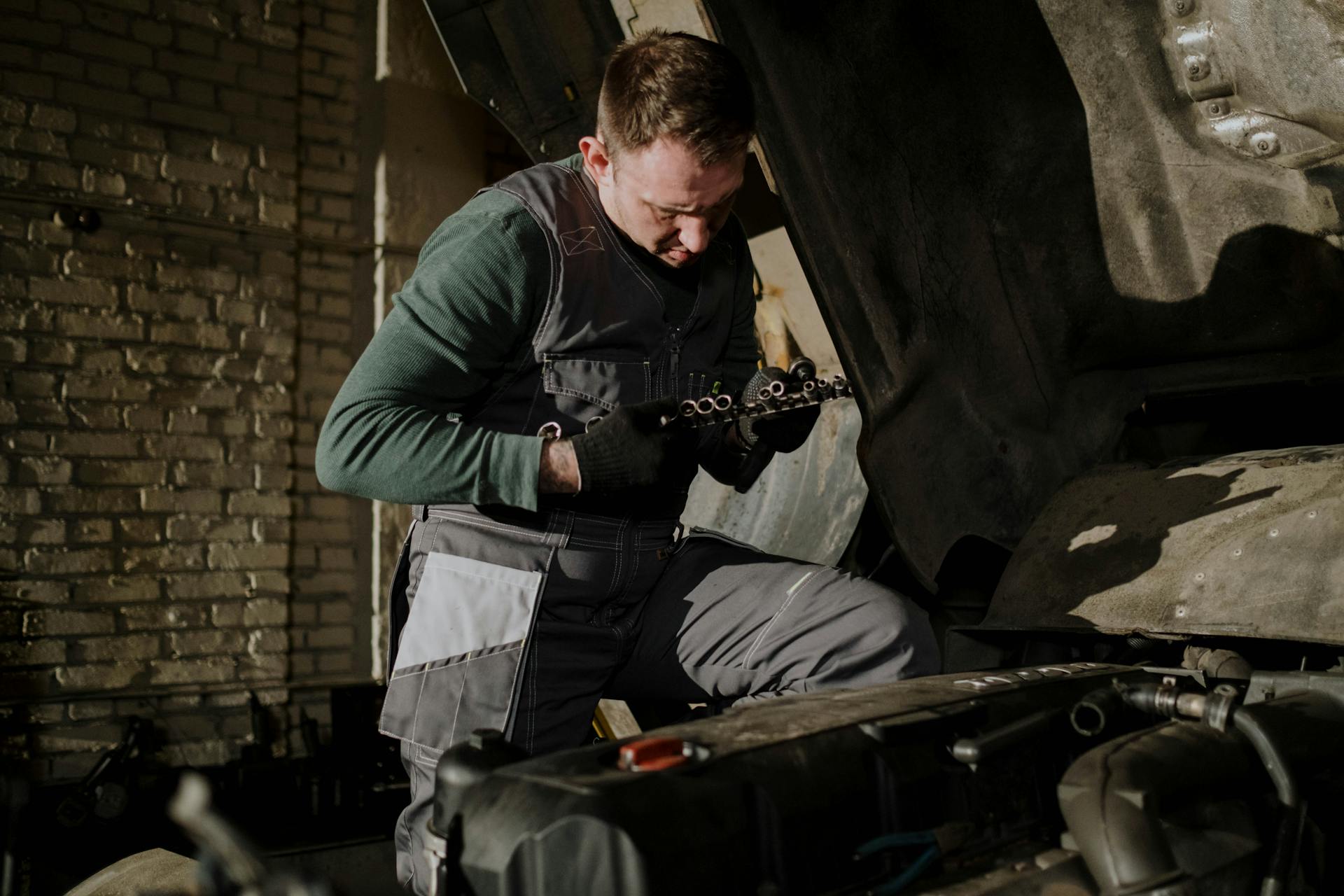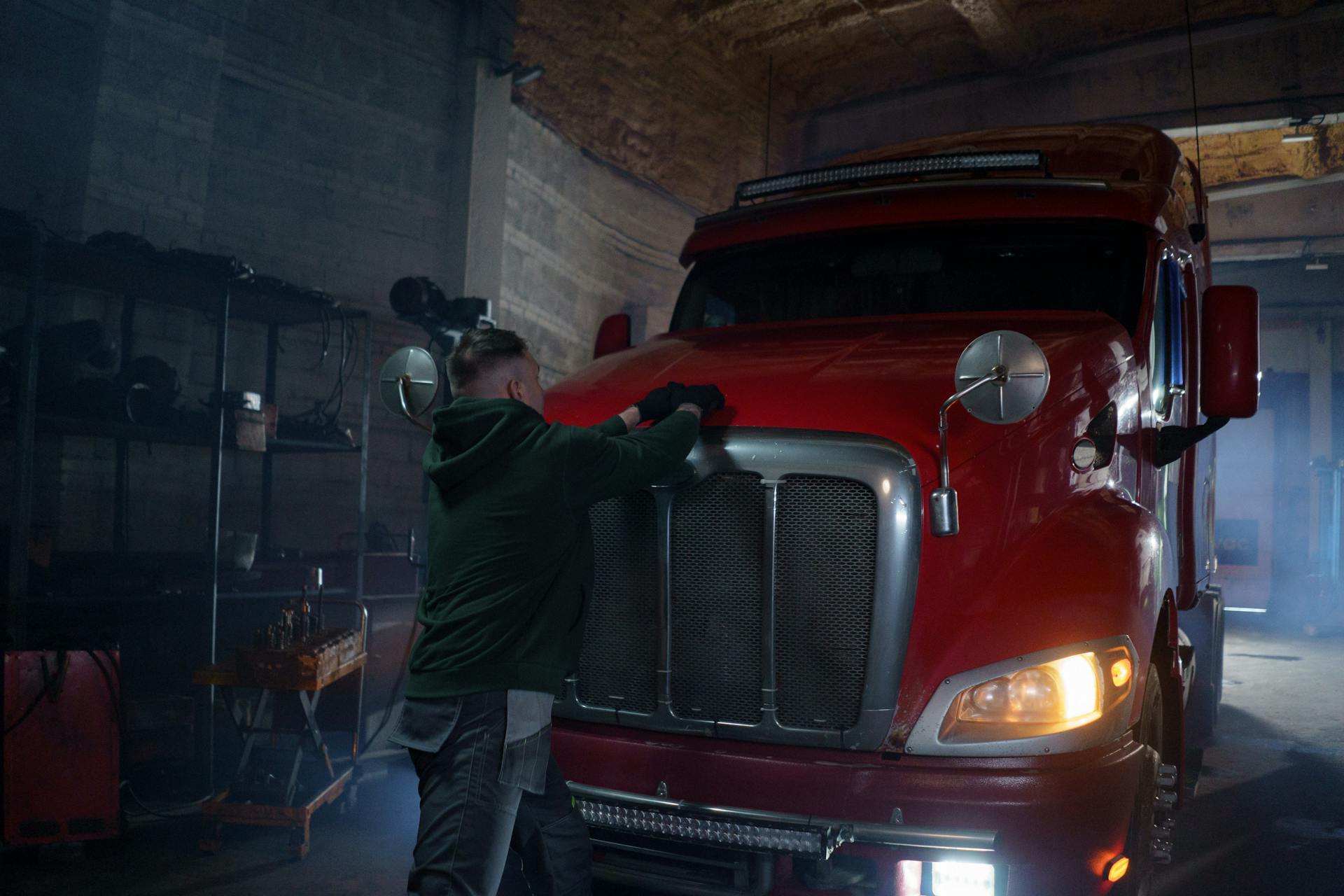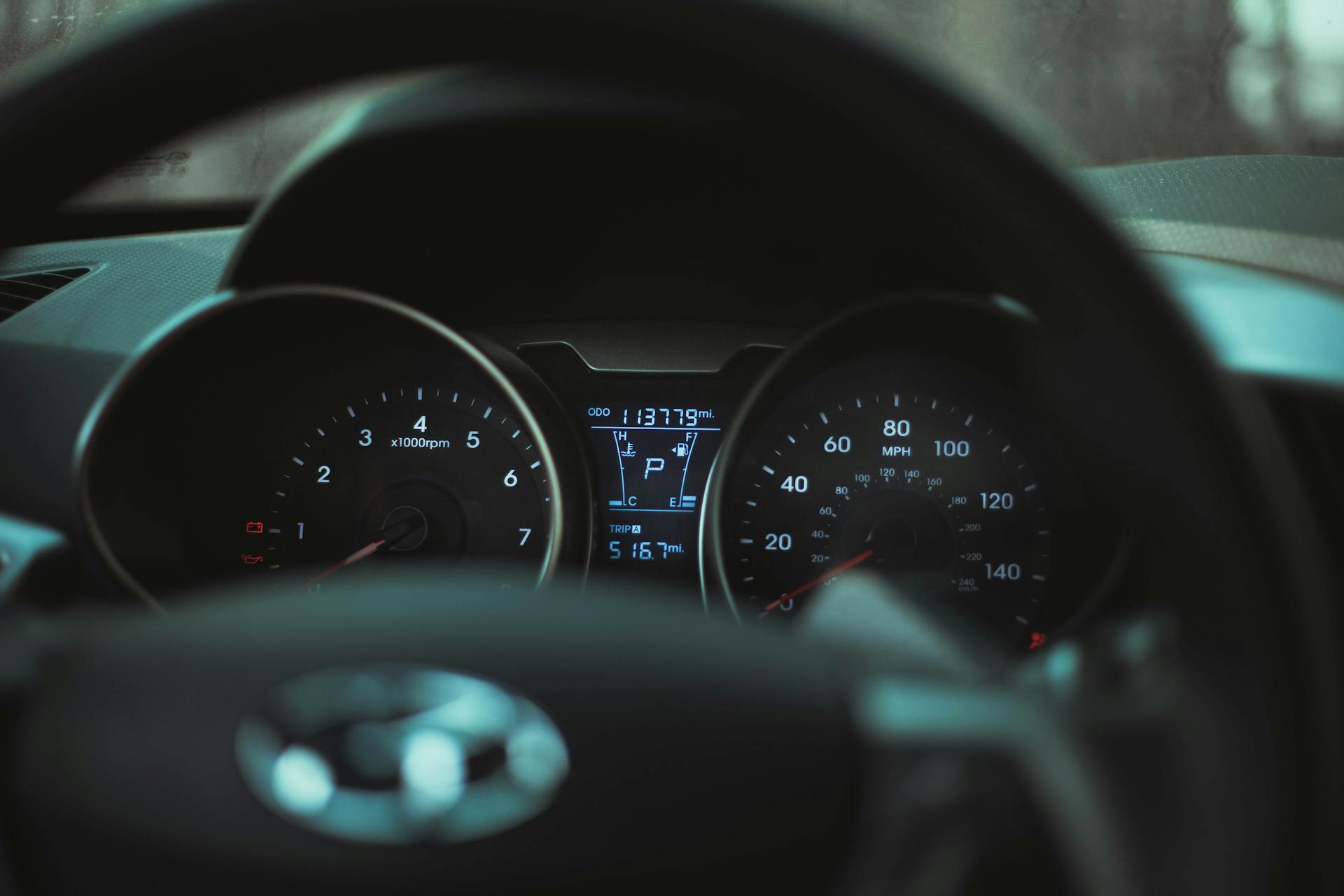
The air brake system on semi trucks is a complex network of components that play a crucial role in ensuring safe transportation of goods.
There are two main types of air brake systems: S-Cam and Pushrod.
S-Cam systems use a cam to push the brake shoes against the drums, while Pushrod systems use a rod to apply pressure.
Proper maintenance is key to preventing brake system failures, which can be catastrophic on the road.
Regular inspections should be performed every 12,000 to 15,000 miles to check for worn-out brake pads, damaged hoses, and low air pressure.
A well-maintained air brake system can extend the life of the brake components and prevent costly repairs down the line.
Understanding Air Brakes
Air brakes are a critical component of semi trucks, used to enhance vehicle safety by using compressed air instead of hydraulic fluid to apply the service brakes and release the parking brake.
The air brake system consists of multiple air circuits, which work together to ensure safe and efficient braking. Air is pressurized by an engine-mounted compressor, which pumps the air into the air storage tanks.
Air brakes can be either drum brakes or disc brakes, or a combination of both. The parking brake engages by spring force in the parking brake portion of the spring brake chamber when the air pressure in the chamber is released.
Proper maintenance and synchronization of the air brake system's components are crucial for its overall functionality and safety. This includes regular checks of the air compressor, governor, and valves to ensure they are working correctly.
How It Works
Air brakes are a vital safety feature in vehicles, especially in trucks and buses. They work using compressed air instead of hydraulic fluid.
The air compressor, usually engine-mounted, pumps air into the air storage tanks, which store the compressed air until it's needed. These tanks are a crucial part of the system.
When you press the brake pedal, air pressure releases from the reservoir through a series of valves and hoses, reaching the brake chambers or brake calipers. This process is controlled by a governor that regulates the air pressure within specified limits.
The brake chambers convert the air pressure into mechanical force, activating the brake shoes or pads against the drum or rotor. This slows down or stops the vehicle.
Air pressure is used to apply the service brakes and release the parking brake. The parking brake engages by spring force in the parking brake portion of the spring brake chamber when the air pressure in the chamber is released.
If air pressure drops too low, the force exerted by the spring in the chamber will apply the brakes on all wheels. This is a safety feature that helps prevent accidents.
Provide More Stopping Power
Air brakes provide more stopping power than hydraulic brakes because they use compressed air to create braking force. This is a crucial difference that makes air brakes more effective for big rigs.
Air brakes can generate much more stopping power than hydraulic brakes. In fact, they can stop a big rig much faster than hydraulic brakes can.
The reason for this difference is that air brakes use compressed air to apply the service brakes and release the parking brake. This allows them to create a lot of braking force quickly.
Air brakes are a critical component of diesel vehicles, and they're used to enhance vehicle safety. They're especially important for big rigs, buses, and tractor-trailers that carry heavy loads.
The parking brake in an air brake system can also be used as the emergency brake system. This is because it engages by spring force when the air pressure in the chamber is released.
Less Sensitive to Temperature Variations
Air brakes are less sensitive to temperature variations because they use air, which isn't affected by temperature changes like fluids are.
This means that air brakes can perform consistently in different climates, unlike hydraulic brakes that rely on fluids that can thicken or expand with temperature changes.
Air brake failure can cause a truck driver to lose control of the truck's braking, which is a serious safety concern for the driver and other motorists on the road.
The difference in temperature sensitivity between air brakes and hydraulic brakes can be significant, especially for truck drivers who operate in areas with extreme temperature fluctuations.
Types of Semi-Trucks
Semi-trucks come in different types, each with its own unique features.
The most common types of semi-trucks are the Day Cab, the Sleeper Cab, and the Double Cab.
A Day Cab is a semi-truck with a short sleeper berth, ideal for short-haul routes.
The Sleeper Cab is a semi-truck with a full-sized sleeper berth, designed for long-haul routes.
Double Cab semi-trucks have two separate cabs, one for the driver and another for the crew.
Flatbed semi-trucks are designed for hauling oversized or heavy loads, often used for construction or agricultural purposes.
Maintenance and Inspection
Inspecting air brakes is a critical part of semi-truck maintenance. You should check slack adjusters to make sure they're adequately adjusted and aren't sticking.
Air lines should be checked for cracks, leaks, and kinks in the lines. Brake chambers should be inspected for damage and excessive wear. Brake shoes should be inspected for wear and tear. Wheel bearings should be looked for signs of excessive heat or grease leakage.
Here's a quick checklist of things to inspect:
- Slack adjusters: Make sure they're adequately adjusted and aren't sticking.
- Air lines: Look for cracks, leaks, and kinks in the lines.
- Brake chambers: Check for damage and excessive wear.
- Brake shoes: Inspect for wear and tear.
- Wheel bearings: Look for signs of excessive heat or grease leakage.
Preventative Maintenance Tips
Preventative maintenance is key to keeping your air brakes in good working order. Regularly inspecting your air brakes can help you catch potential problems before they become major issues.
Make sure to keep the air lines clean and free of debris, as this can help prevent leaks and other problems. Inspect the air hoses for cracks or leaks regularly, and check the air tanks for signs of corrosion or damage.
Properly sealing and lubricating the brake valves is also crucial for maintaining your air brakes. Ensure the compressor is functioning properly, as this will help keep the air pressure at the correct levels.
Here are some key components to check during your air brake inspection:
- Slack adjusters: Make sure they're adequately adjusted and aren't sticking.
- Air lines: Look for cracks, leaks, and kinks in the lines.
- Brake chambers: Check for damage and excessive wear.
- Brake shoes: Inspect for wear and tear.
- Wheel bearings: Look for signs of excessive heat or grease leakage.
Remember, preventative maintenance is always better than waiting for a problem to arise. By following these tips and regularly inspecting your air brakes, you can help ensure the safety of yourself and others on the road.
Check Buildup Rate
To check the rate of air pressure buildup, remove the chock blocks and stow them away while the truck is off.
Ensure the truck is off before removing the chock blocks.
Start the engine and hold the accelerator at around 1200 RPM to build up air pressure.
The pressure should build from 85 to 100 PSI within 45 seconds at operating rpms.
Troubleshooting and Repair
Low air pressure in the brake system can be a major issue, and it's essential to address it as soon as possible. If the air pressure falls below a certain psi level, the brakes won't work correctly, which can be caused by a leak in the system, a problem with the compressor, or simply failing to keep the system properly pressurized.
To fix low air pressure, you should stop as soon as safely possible and call for help. This is crucial to prevent accidents and ensure your safety on the road.
Brake fade is another common problem that can occur with air brakes. It's caused by a loss of braking power due to excessive heat build-up in the brake system.
To prevent brake fade, it's essential to let the brakes cool down before using them again. This will help prevent the brakes from feeling soft and unable to stop the vehicle effectively.
Most Common Issues
Low air pressure is a common problem that can cause air brakes to malfunction. If the air pressure in the brake system falls below a certain psi level, the brakes won't work correctly.
A leak in the system, a problem with the compressor, or failing to keep the system properly pressurized can all cause low air pressure. It's essential to address this issue promptly to avoid accidents.
Brake fade is another common issue that occurs when excessive heat builds up in the brake system, causing a loss of braking power. The brakes will feel soft and won't be able to stop the vehicle as effectively.

To fix brake fade, you need to let the brakes cool down before using them again. This is the only solution, so be patient and wait for the brakes to cool down.
Here are the most common issues with air brakes and how to fix them:
- Low air pressure: Stop as soon as safely possible and call for help.
- Brake fade: Let the brakes cool down before using them again.
Troubleshooting and Repair
To troubleshoot air pressure issues, start by testing the low pressure warning signal. This involves stepping on and off the brake pedal repeatedly to reduce the air tank pressure.
The warning light and buzzer should come on before the pressure drops to less than 60 PSI in the air tank, or half of the maximum pressure.
Next, check that the spring brakes come on automatically when the air pressure falls to approximately 20-45 PSI. Both buttons on the dash should pop out in this situation.
Testing and Safety
The air brake system on a semi-truck is critical for safety, and regular testing is essential to ensure it's working properly.

There are multiple air circuits in the system, and the parking brake can also be used as the emergency brake system.
To complete an in-cab air brake test, you'll need to follow a series of steps, starting with a walkaround inspection.
The protection valve pop-out test is the next step, where you'll continue to fan off the air pressure by stepping on and off the brake pedal to reduce tank pressure.
Drum brakes and disc brakes, or a combination of both, can be used in air brake systems, and the overall functionality and safety of the system rely on proper maintenance and synchronization of its components.
To conduct a service brake test, drive forward slowly at about 5 mph and apply the brake firmly, making sure your unit stops with no pulling to either side and without any grinding noises.
The type of driver you are, the company you work for, and the type of truck you drive can impact how you complete the testing process, so be sure to consult your company guidelines or speak with your leader for more information.
Regular testing and maintenance of the air brake system can help prevent accidents and keep you and others on the road safe.
Benefits and Advantages

Air brakes offer greater stopping power due to increased friction, making them ideal for heavy-duty vehicles like trucks and buses.
Air brakes are built to last for much longer distances, reducing the need for frequent replacements.
They're also more reliable than traditional brakes, as they don't rely on friction between the brake pads and the brake rotor to stop the vehicle.
This means they're less likely to suffer from brake fade, which can cause the brakes to lose their stopping power over time.
Air brakes are also easier to maintain and repair than traditional brakes, making them a more cost-effective option in the long run.
Benefits of Semi-Trucks
Semi-trucks play a vital role in modern transportation, offering numerous benefits that make them an essential part of our economy.
Their large capacity allows them to transport massive amounts of goods, reducing the need for multiple smaller vehicles and decreasing transportation costs. They can carry up to 40 tons of cargo, making them a cost-effective option for businesses.
Semi-trucks are also highly efficient, with many models achieving fuel economy ratings of up to 7 miles per gallon. This is crucial for long-haul drivers who need to cover vast distances.
Their advanced safety features, such as airbags and anti-lock braking systems, help reduce the risk of accidents and protect both drivers and passengers.
Are More Reliable
Air brakes are more reliable than traditional brakes because they don't rely on friction to stop the vehicle, which means they're less likely to suffer from brake fade.
Air brakes have fewer parts that can fail, reducing the likelihood of leaks and overheating.
They last longer than hydraulic brakes, giving you more miles out of them before they need to be replaced.
This increased reliability also makes air brakes a more cost-effective option in the long run, as you'll spend less on maintenance and repairs.
Frequently Asked Questions
What happens when you press the brake pedal with air brakes?
Pressing the brake pedal with air brakes applies more air pressure, engaging the brakes. Releasing the pedal reduces air pressure, releasing the brakes
What is the pressure on air brakes on a semi truck?
Air brakes on a semi truck typically reach a maximum pressure of approximately 120 PSI
Do air brakes run out of air?
Air brakes can experience a temporary loss of air pressure due to repeated service brake applications, but they don't actually "run out" of air. The system will automatically recharge when the compressor kicks in to replenish the air reservoir.
Sources
- https://www.uti.edu/blog/diesel/air-brakes
- https://www.ccjdigital.com/maintenance/article/15290514/the-anatomy-of-a-trucks-air-brake-system
- https://repair.diesellaptops.com/air-brakes-on-commercial-trucks-explained/
- https://schneiderjobs.com/blog/checking-air-brakes
- https://www.roadrescueinc.com/blog/why-do-semi-trucks-use-air-brakes/
Featured Images: pexels.com


